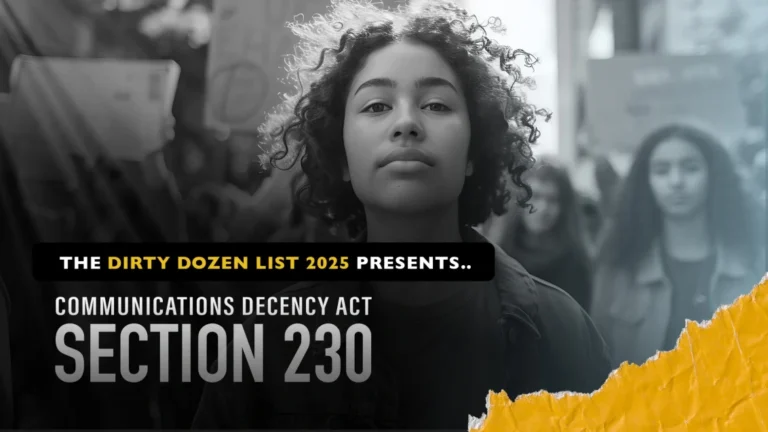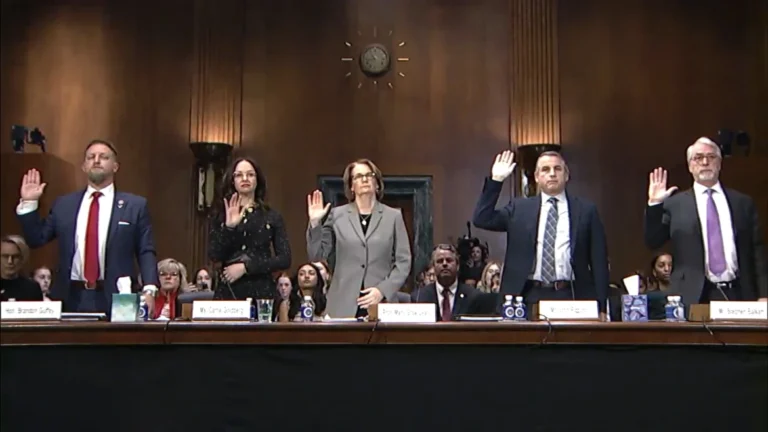
Copy of Summary of Research reviewed by NCOSE by topic –download here
Download copies of event and speaker handouts here.
Videos will be available here in the next month.
View photos from the event here:
There is Hope: Confronting the Rise of Child-on-Child Harmful Sexual Behavior Symposium Recap
On March 20-21, 2019, The National Center on Sexual Exploitation hosted a national symposium at The Catholic University of America in Washington, DC on a very important, but often overlooked topic: child-on-child sexual abuse. The event, titled “Out of the Shadows: Confronting the Rise of Child-On-Child Harmful Sexual Behavior”, was attended by over 350 people in-person, as well as hundreds more via a live stream, ranging from social workers, educators, government officials, law enforcement, psychologists, and other child safety experts.
This symposium was being held in collaboration with the National Catholic School of Social Service at The Catholic University of America and Protect Young Minds. CEUs were provided for licensed social workers are available from the Maryland Network Against Domestic Violence (MNADV).
Although the topic was heavy, the event was filled with hope as the speakers shared both the challenges of this national issue, as well as innovative strategies and solutions that the attendees could take back to their communities to begin healing. Child-on-child harmful sexual behavior can be filled with shame and stigma, but we are confident that the attendees left feeling energized and ready to tackle this problem more directly, bringing this issue, usually so shrouded in darkness, into the light.
The speakers shared the latest research, explored the problem from multiple perspectives, and discussed solutions moving forward. Three main messages stood out throughout the two-day program:
- There needs to be comprehensive and consistent training, protocols, and response throughout communities for this issue. That means social workers, child services, medical practices, and law enforcement all need to work together in a multidisciplinary team approach system.
- The language we use surrounding this issue matters. It affects the policy, prosecution, and healing of both victims and those who have sexually abused. We need to remember that in these cases, they are children first. Support and rehabilitation needs to be widely available for both the victims and the perpetrators. As one speaker, Mary Anne Layden said, “therapy is good, prevention is better”.
- The technology-obsessed world we live in matters! Social media, popular culture, and pornography simply cannot be escaped, and they are strong teachers of our children. Parents, educators, and other child service workers need to be aware of the potential dangers and effects the media can have, and how it plays a huge part in many child on child sexual abuse cases.
Want a quick recap of the event’s agenda? Here are some brief highlights and standouts from the symposium:
Kristen Jenson, Founder, Protect Young Minds & Author, Good Pictures Bad Pictures
- Founder of Protect Young Minds, Kristen Jenson kicked off the symposium with a message on protecting kids from the dangers of pornography, calling porn “the greatest serial abuser on the planet”. She also gave a breakout session talk on her work with preventing children from being exposed and harmed due to pornography.
- She shared some great potential solutions to children “hiring” porn to be their sex education, saying increased awareness and treatment, guidance for schools, educational resources, and leading with hope can help stop the tide of porn-induced child on child harmful sexual behavior.
Jane Silovsky, Ph.D., Professor of Pediatrics, University of Oklahoma Health Sciences Center & Director, National Center on the Sexual Behavior of Youth
- Dr. Silovsky gave both a keynote address and a breakout session talk during the first day of the symposium. She stressed the importance of collaborative community response to this issue, including parents, to better raise awareness and prevention.
- In both her talks, she reminded everyone that these crimes involve children on both sides, and we need to see them as children first. While that doesn’t diminish the seriousness of the issue, Dr. Silovsky’s message reminded the crowd that there is hope for both victim healing as well as rehabilitation and change for the child aggressors. She said, “the path to healing everybody comes with seeing them as youth and responding effectively”.
- “Change has to happen, and we have the power to make it happen”.
Heidi Olson, Sexual Assault Nurse Examiner Program Coordinator, Children’s Mercy Hospital
- A sexual assault nurse examiner (SANE), Heidi Olson gave a keynote talk that addressed the medical and law enforcement side of the issue, especially highlighting the victims in these cases. She spent time breaking down many myths that surround sexual assault, such as the myth that all victims will have physical evidence of a struggle. Unfortunately, this is often not the case, making these cases even more difficult when seeking justice.
- Heidi also shared some insights into the trends she has seen in her work as a SANE, including the rise of many assaults mirroring the acts seen in popular pornography, saying “as amazing as technology can be, we are seeing horrific ramifications”. The most important thing we can do in supporting victims of sexual assault is to validate and believe them when they come forward.
Cordelia Anderson, Director, Sensibilities, Inc.
- Working with cases like these for decades, Cordelia Anderson is an expert in restorative and transformative justice and gave two talks on the first day. Inspiring the audience, she shared a powerful message of hope and healing for both victims and those who have hurt others. Restorative justice is all about accountability and genuine change. When we give those opportunities to children, we can see the values of compassion, listening, equality, and respect.
- “Accountability is a radical form of love”.
Robin Reber, Admissions Director, Star Guides
- Robin Reber is a director of Star Guides, a leading youth treatment facility. She shared treatment options in her breakout session talk, and gave team talk with Dan Sanderson on the second day of the symposium.
- Understanding the difficulties parents often face when seeking treatment options, she shared the problem of children only showing the tip of the iceberg to their parents, and the importance of widely available treatment options and knowledge for families. Like Dr. Silovsky, she stressed the importance of a uniform treatment and response plan across disciplines to help protect and treat these children.
- We need to “move away from demanding an eye for an eye and start to heal our communities”.
Dan Sanderson, Clinical Director & Founder, Star Guides
- Dr. Sanderson gave both a breakout session and keynote address during the symposium, sharing his perspective as an expert child development psychologist. Working closely with Robin Reber at Star Guides, Dr. Sanderson shared both heart-wrenching and inspiring quotes from real families that have gone through the treatment process for their children.
- “Loving your child means getting them the help they need”.
- “As parents we do wish we had known more about empathetic listening”.
Melissa Grady, Associate Professor, National Catholic School of Social Service
- Dr. Grady, a social service expert at Catholic University, shared powerful insight into the policies and trauma that surrounds and informs child on child harmful sexual behavior. Breaking down the impact of federal policies like the child sex offender registry, she shared that public shaming like the registry has had many unintended consequences, including housing, employment, social skills, and education for many children.
- In her keynote address, Dr. Grady explained how trauma enforces and explains many cases of child on child sexual abuse as well. Speaking on trauma, she said “it’s hard to find a domain where it doesn’t touch” in the lives of both children and adults. Her talk especially stressed the importance of early intervention and for the improvement of trauma-informed therapy and treatment.
Gail Dines, President, Culture Reframed
- Dr. Dines gave a powerful address on the influence pornography has on childhood development. Explaining how objectifying media can influence even adults, she said, “we cannot leave our kids to figure this out by themselves”. Pornography has socialized our girls to be “porn ready”, and our boys to believe that violence is sexy.
- Calling pornography “the most sophisticated business model in the world”, she asked the audience what they will say when a future child asks them what they did to fight this pornography takeover. She, and NCOSE, believes that every single child in the world deserves to be fought for. Pornography is everywhere, but Dr. Dines left the audience with hope that the industry can be changed.
Teresa Huizar, Executive Director, National Children’s Alliance
- Teresa Huizar of the National Children’s Alliance gave a keynote address on the barriers and solutions to children services. Calling on child advocacy centers to take both victim and aggressor rehabilitation work, she shared her own experiences with many cases.
- She stressed the importance of prevention and treatment, explaining that with more effective prevention, the world will have less victims. Leaving us with hope, she left with these inspiring messages: that children can be treated, evidence-based treatment is available, the multidisciplinary team approach works and can be applied to these types of cases, and that these kids are a priority.
Lisa Thompson, Vice President of Policy & Research, National Center on Sexual Exploitation
- NCOSE’s own Lisa Thompson gave a helpful and informative look into how sexting and social media can be dangerous, especially for vulnerable children. Grooming, sextortion, revenge pornography, and other dangerous outcomes are all possible if parents are not aware of these issues.
- The problem is not about control, it’s about child protection. Ignoring the realities of social media and technology doesn’t help parents, children, or victims.
Paul Stern, Retired Prosecutor, Snohomish County, Washington
- A retired prosecutor who used to work child sexual abuse cases, Paul Stern implored the audience to find creative solutions to our current obstacles, and follow the data when coming up with policy. To this end, he said “the worst reason to do something is because that’s the way we’ve always done it. There’s always a better way”.
- Currently, policy surrounding these cases has always been a “one size fits all” approach. From data and experience, none of the speakers would agree that this has worked when dealing with sexual abuse, both with victims and aggressors. Mr. Stern shared that 80% of all juvenile treatment is adapted from adult treatment. How is this good public policy?
- In closing, he said, “being smart is better than being tough”. Instead of continuing to do harm with uninformed and outdated policies, it is better to do nothing until we can come up with something better.
Mary Anne Layden, Director, Sexual Trauma and Psychopathology Program Center for Cognitive Therapy, Department of Psychiatry University of Pennsylvania
- Dr. Layden shared the influence pornography has had on both child victims and children who have committed sexual abuse. Pornography has created a “miseducation” of sex, teaching warped sexual and social scripts to our children and creating a culture of sexual entitlement for men, and sexual victimization for women.
- We need to stop letting porn teach the sex talk to our children and making money off of it in the process.
- Like many other speakers, she stressed the need for multisystemic therapy.
We would like to thank all of our speakers for sharing their insights, research, and inspiration with the audience and with us. Thank you to all our attendees, we are grateful for your dedication to these issues and hope you walked away empowered to fight child on child harmful sexual behavior in a collaborative, responsible way.
You can download a copy of the full agenda here. Read through our research summary here. Finally, you can find copies of all our event and speaker handouts here.



